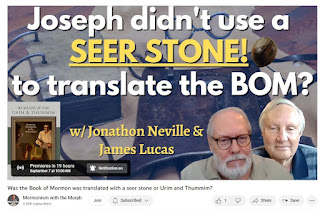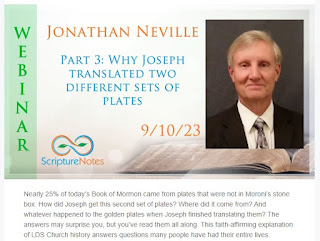April 3 and the anti-Cowdery M2Cers–again
On April 3, it’s a good time to think about Oliver Cowdery. This is important because in our day, many LDS scholars teach that Oliver Cowdery misled the Latter-day Saints (and the entire world) about the origin and setting of the Book of Mormon. Below we’ll discuss a recent online posting to that effect.
As we like to say, we seek “no more contention.” But that objective depends on clarity, charity, and understanding. We assume everyone acts in good faith, and we seek understanding instead of convincing, coercing, or compelling agreement.
But without clarity, contention persists and festers. So let’s start with some clarity.
_____

On April 3, 1836: Elijah, Moses, Elias, and the Savior appeared to Joseph Smith and Oliver Cowdery in the Kirtland Temple and restored the keys of the gathering and of temple work. That’s exactly 188 years ago today. Joseph and Oliver were the President and Assistant President of the Church at the time.
The only record we have of that event is a third-person journal entry by Oliver’s brother, Warren.
https://www.josephsmithpapers.org/paper-summary/visions-3-april-1836-dc-110/1
Warren’s account was changed to first person for inclusion in the Doctrine and Covenants.
Joseph and Oliver were the only witnesses to the restoration of keys in the Kirtland temple, just as they were the only witnesses of the restoration of the Aaronic and Melchizedek Priesthoods. Priesthood holders today obtained that Priesthood through Oliver Cowdery, not Joseph Smith, because Oliver received it directly from John the Baptist and Peter, James and John, and Oliver, along with the other two witnesses, David Whitmer and Martin Harris, selected and ordained the first Apostles in February 1835.
During the same month that Oliver selected and ordained the first Apostles, February 1835, one of Oliver’s eight essays about Church history was published in the Messenger and Advocate. This was Letter IV, in which Oliver described Moroni’s visit, which we can all read in Joseph’s own journal.
https://www.josephsmithpapers.org/paper-summary/history-1834-1836/64
Oliver was merely the Assistant President of the Church, but he was the principal scribe and witness to the translation of the Book of Mormon. He had visited the repository of Nephite records in the Hill Cumorah. He wrote about the origin and setting of the Book of Mormon in these essays that he wrote with the assistance of Joseph Smith.
On April 3, we remember that Oliver wrote these essays a year prior to the restoration of keys in the Kirtland temple.
But as I wrote at the beginning of this post, recently an online discussion revived the anti-Oliver Cowdery narrative promoted by the M2Cers, such as Scripture Central, here:
For an analysis of that “kno-why,” see
https://www.bookofmormoncentralamerica.com/2024/04/legacy-post-no-wise-453-scripture.html
_____
Part 1 below discusses the plates and Cumorah. Part 2 discusses the 8 essays on Church history published in the Messenger and Advocate in 1834-5.
Part 1
From the online discussion:
“the records were deposited and moved many times in the Book of Mormon. The last thing we read about them is that Mormon left all the records EXCEPT the gold plates in Cumorah. Moroni eventually received the plates and finished the record. Then he wandered for 30+ years. So, the gold plates were NOT deposited in the Book of Mormon Hill Cumorah.”
Hopefully everyone who reads this can spot the logical fallacies here, but apparently there are enough M2Cers still making this argument that we owe it to the public to once again go through the topic.
If we can all agree that Mormon put the repository of records in the Hill Cumorah, as stated in Mormon 6:6, then Oliver’s declaration that the hill in New York is the Hill Cumorah directly follows from Oliver’s visit to that repository.
Nothing in the text says or implies that Moroni deposited the abridged plates in another hill. In fact, during his first visit to Joseph Smith, Moroni identified the location as the “hill of Cumorah,” a point Joseph Smith himself reiterated in D&C 128:20.
Orson Pratt explained there were two departments in the hill, one for the repository of records, and the other for the abridged plates. This has all been well=known for decades, and would still be well-known among Latter-day Saints if not for the efforts of M2C advocates to downplay, censor, and outright contradict the historical record.
People can believe whatever they want, but it is irresponsible to ignore and suppress the historical record. M2Cers are free to disagree with what Oliver, Joseph, their contemporaries and successors said, but they owe it to themselves and everyone else to be crystal clear about their positions, based on the clarity of full disclosure.
_____
Part 2
It’s difficult to compose a more concise collection of logical and factual fallacies than this paragraph has. Again from the social media post:
“Ah, the 8 letters written by Oliver Cowdery. If we are to believe Oliver then we must accept that there was no First Vision and that Moroni’s visit was Joseph’s first celestial contact. And that Joseph was visited by a “host of angels” on that same night. While historically important to show the wide variety of beliefs in the early Church, these letters are far from authoritative. They were published BEFORE Joseph became the editor of the Times and Seasons. Although never refuted by Joseph, they are clearly not doctrinal.”
One persistent theme of the M2Cers is that there was “a wide variety of beliefs in the early Church.
While this may be true on a variety of topics, it is unambiguously not true of the location of the Hill Cumorah. Yet this logical fallacy continues to fester.
It’s useful to remind people that these letters are in Joseph’s own journal, as well as the Messenger and Advocate, Times and Seasons and other Church newspapers of the day.
It’s also relevant that Joseph himself left no record of the first vision before Oliver wrote these letters, apart from the private 1832 history which said nothing about Christ and God appearing.
Anyone can read the accounts of the First Vision in the Joseph Smith Papers, here:
https://www.josephsmithpapers.org/site/accounts-of-the-first-vision
We can all see that the first known verbal recitation of the First Vision by Joseph Smith was in November 1835, months after Oliver wrote the letters about the Restoration.
People who reject Oliver’s letters because he didn’t mention the First Vision are insisting that Oliver was supposed to either (i) write an account of the First Vision before Joseph was ready to make it public (assuming Oliver even knew about it), or (ii) make up the First Vision account to conform to the account that Joseph’s scribes would compile years later.
It’s also significant that both Lucy Mack Smith and William Smith related Joseph’s early years without mentioning the First Vision. In their accounts, Moroni’s visit was the answer to Joseph’s prayer about which church to join. In the second version of Lucy’s history, she still didn’t mention the First Vision. Instead, the editors inserted the First Vision narrative that is now Joseph Smith-History.
[BTW, this point contradicts the M2C narrative that Lucy incorporated a “late, false narrative” about Cumorah in her history. Lucy didn’t even incorporate the First Vision account, which was well known in 1844-5 when she related her memories of Joseph’s early years. Instead, she reported what she remembered, and among those memories were two times when Joseph referred to Cumorah before he even got the plates.]













